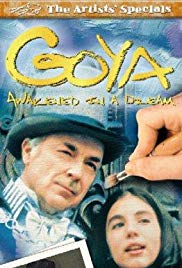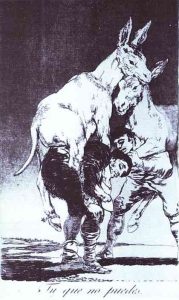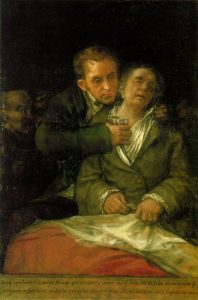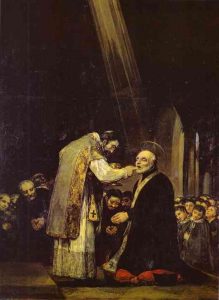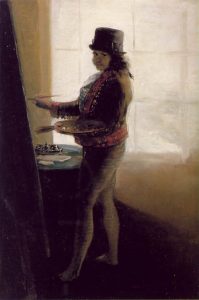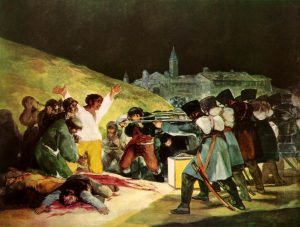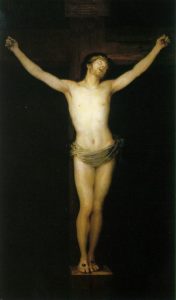Comments on Some of the Paintings Shown in This Learning Guide
“The Execution of Madrileños on the Third of May” — (Click here for full sized image.) The first European painting of its time to show the horror of modern war, “The Execution of Madrileños on the Third of May”, has been described as the first work of modern art. Goya does not attempt to paint the scene in a realistic manner. Nor is there an attempt to show heroic forces battling each other. We are shown what would be remembered by a witness to the event. This painting established a genre of paintings that record the horrors of war. One is reminded of Picasso’s “Guernica,” which carried on this tradition.
The flow of energy in the “The Third of May” starts with the soldiers pointing their guns at the man about to be executed. The figure at the far left of the picture, protecting his head with his hands, and the line of the hill in the background accentuate this. These last two elements do not immediately register. Instead, the color red draws the viewer’s eye down to the blood on the ground. The French soldiers all have the same stance, aggressive and immovable at the same time. Their faces are not shown. They are a weapon, an inhuman force framing the painting and driving the situation being described.
The use of color serves the meaning and focus of the work. The colors, all except for the lantern, the man to be executed and the blood of the dead, are muted greys and browns. Our eye focuses on the white of the man’s shirt, soon to be stained by the very red blood that we see on the ground.
The man to be killed does not have his hands bound. Instead, his arms are raised in a gesture which is at once Christlike and defiant, accepting his own fate but predicting, insisting upon, the ultimate defeat of the French. With his arms raised to address heaven and mankind, he is also horrified that he is about to die. This figure symbolizes all of the people who were slaughtered in executions by the French during the war.
No one is idealized in this painting. The Madrileño to be executed is not shown as particularly handsome. If he is heroic, it is the heroism of the unlucky: a common man, caught by the victors and raised to the status of sacrificial lamb. His face shows his realization of his impending death.
The executioners are not demonized. We don’t even see their faces. They act in unison, machine-like, as impersonal instruments of death. Their faces are tilted down and they appear not to be looking at where their guns are pointed, at the man they are about to kill. Their victim, on the contrary, looks directly at them and aims his appeal to them as well as to us. But they are deaf to it.
The painting is not painted in a realistic manner and has been held out as a classic example of expressionism in which the artist seeks to depict not objective reality but instead the subjective emotions and responses that objects and events arouse in him. Irrelevant details are suppressed and what is shown is clearly intended to create emotional effect and convey meaning. “The Third of May” is more than the description of an event, it is an argument, an emotion, a vision of horror, a cry of anguish, and an homage to the common man/victim of war. While this painting and its companion “The Uprising at Puerta del Sol on the Second of May” depict specific historical events, they have come to symbolize the horror of all modern war. “The Third of May” has gone further and has become one of the “archetypical images that condition the very tenor of existence after their completion.” Goya by Fred Licht p. 166.
“Self-Portrait” (Click here for full sized image.) — Note how the light coming in from the window creates a three-dimensional affect. Goya wears a hat with clips for candles. As shown in the film, hats such as this allowed Goya to see and paint at night.
“The Forge” (Click here for full sized image.) — The viewer is looking up to the figures in the painting. This makes them look monumental. The energy of both the blacksmith and his helper, who is holding the metal to be hammered, are focused on their tasks. The room is empty of the usual implements of the blacksmith trade. This allows the dark colors of the backdrop to serve as a frame for the figures in the painting. Goya said that, “My eye never sees outlines or particular features or details…. My brush should not see better than I do.” Analysis and quotation taken from What Makes a Goya a Goya, Metropolitan Museum of Art, page 41.
“The Forge” is also cited as an example of expressionism in Goya’s work.
“The Crucified Christ” (Click here for full sized image.) — This is the painting that won Goya admission to the Royal Society of San Fernando, recognizing that he was among the most accomplished artists in Spain at that time. The style is realistic, distinguished from the expressionism of Goya’s later work (“The Forge” and “The Execution of Madrileños on the Third of May”) and the dark fantasies of the “Black Paintings”
“Goya and his Dr. Arrieta” (Click here for full sized image.) — The Goya in the picture is not pleased with the doctor. He doesn’t want to drink the medicine that will save him. He is tired of life and cannot summon the will to live. He is irritated at the disturbance by Arrieta. This character would like to be left alone to slip away. But Dr. Arrieta cradles him with infinite kindness, insisting that he drink the medicine that will cure him.
This painting comes from a traditional Spanish religious art form called the “ex-voto” in which a scene of a catastrophe is shown along with the Virgin Mary or an interceding saint who has protected the person shown to be at risk. The image is dedicated to the holy protector by an inscription at the bottom. In this painting, Goya takes this religious form and makes it secular.

